Last updated: November 4th, 2024

In 2024, Amrita Vishwa Vidyapeetham reaffirmed its commitment to the United Nations Sustainable Development Goal 6 (SDG 6), “Ensure availability and sustainable management of water and sanitation for all” through its comprehensive approach to water-conscious landscaping and planting practices across all campuses. Reflecting a deep alignment with sustainable water management and environmental stewardship, the university has ensured that 80% of its plant species are drought-tolerant, significantly reducing irrigation needs while preserving lush, green, and biodiverse environments.
At Amrita, 32% of all non-built areas are covered by plants, of which nearly 26% are drought-tolerant species. The university employs efficient drip irrigation systems and exclusively uses recycled water for maintaining plantations and gardens. This integrated, ecosystem-based approach illustrates Amrita’s holistic strategy for advancing SDG 6 by reducing freshwater dependency, enhancing water-use efficiency, and promoting resilient green infrastructure across its campuses.
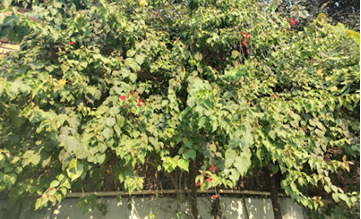
Bougainvillea
Bougainvillea stands as a premier choice among drought-tolerant plants for campus landscaping. This hardy shrub is remarkably easy to grow in any kind of soil and requires only a small amount of water to nurture. It represents one of the hardest shrubs that can be easily planted outdoors to decorate outdoor walls, providing vibrant color and visual appeal while minimizing water consumption. The plant’s resilience and low maintenance requirements make it an ideal choice for sustainable campus beautification.
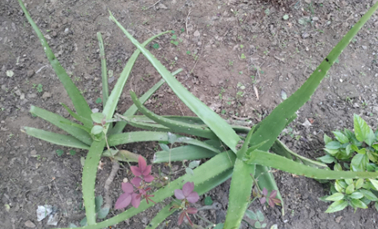
Aloe Vera
Aloe Vera is a cactus-like succulent that typically grows in hot and dry climates. Originally native to Africa, these short-stemmed, drought-tolerant plants fan out from a central stem and possess thick green leaves that contain a watery gel. Aloe Vera is a fast-growing, drought-resistant plant that takes approximately three to four years to mature. Beyond its water conservation benefits, Aloe Vera also provides medicinal value and serves as an educational resource for students studying botany and traditional medicine.

Rubber Tree (Ficus elastica)
The Rubber Tree demonstrates exceptional resilience to irregular watering schedules. Even when neglected for extended periods without water, this plant may show signs of stress but continues to survive. This characteristic makes it particularly suitable for areas where consistent maintenance may be challenging, ensuring that the campus maintains its green appearance even during periods of water scarcity or maintenance limitations.
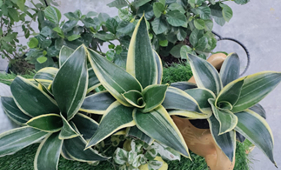
Snake Plant (Sansevieria trifasciata)
The Snake Plant is one of the most resilient drought-tolerant species in the campus landscape. This remarkable grower thrives in both sun and shade conditions, whether watered regularly or not. The Snake Plant stands tall even when watered only occasionally, and can go for weeks at a time without water, especially during winter months. Its adaptability to various light conditions and minimal water requirements make it an excellent choice for both indoor and outdoor campus spaces.

Sapota
Sapodilla trees offer multiple benefits beyond their drought tolerance. These trees can withstand soil salinity, require very little pruning, and are mostly pest-resistant. The combination of low maintenance requirements and productive fruit yield makes sapota trees an economically and environmentally sound choice for campus orchards.
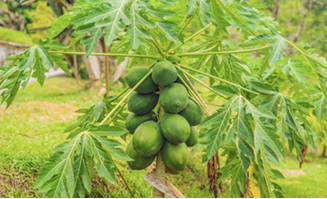
Papaya
Papaya is classified as a drought-tolerant crop due to its ability to survive very dry soil conditions. The papaya plant demonstrates remarkable physiological adaptation by increasing ion concentrations to adjust its osmotic balance during periods of water scarcity. This natural mechanism allows the plant to maintain productivity even under stress conditions, making it a valuable addition to the campus agricultural diversity.

Pineapple
Pineapples are generally tolerant to drought periods, though they do have specific watering needs for optimal growth. Sprinkling systems represent the most suitable irrigation method for pineapple crops. While drought periods can delay the growth and fruit production of pineapple plants, the species demonstrates reasonable resilience. Drought symptoms become evident through leaf wilting and color changes to yellow or brown, providing clear visual indicators for irrigation management.

Jackfruit Trees
Jackfruit trees are moderately drought-tolerant and hold particular cultural significance at the campus. These trees produce fruits that are extensively used in a variety of dishes in South Indian recipes, connecting sustainable agriculture practices with regional culinary traditions. The jackfruit’s versatility as both a fruit and vegetable substitute makes it a valuable food security resource on campus.
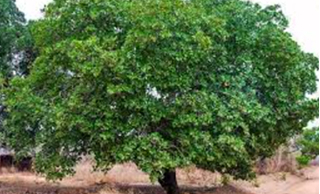
Cashew
Cashew trees are planted extensively throughout the campus due to their moderate drought tolerance once established. These trees provide dual benefits by producing both nuts and cashew apples, contributing to campus food production while requiring minimal water inputs compared to conventional fruit trees.
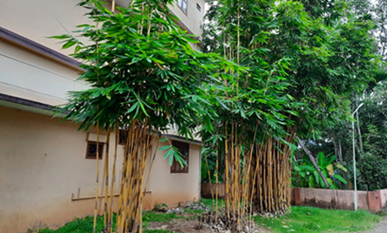
Bamboo
Drought-tolerant bamboo species perform well during prolonged periods without water, though their tolerance has limits. When drought conditions exceed the time and level of dryness that bamboo can tolerate, the plants display stress through yellowing and curling leaves. Bamboo serves multiple purposes on campus, from construction materials to landscaping elements, making it a valuable multipurpose crop despite its moderate water requirements.
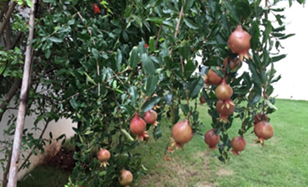
Pomegranate
The pomegranate tree is drought-tolerant, though irrigation is needed for proper fruit production. During the dry season, newly established trees require deep watering every two to four weeks. Once established, pomegranate trees demonstrate excellent resilience to water scarcity while continuing to produce nutritious fruits rich in antioxidants.
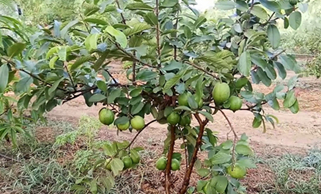
Guava
Guava is notably drought-tolerant and demonstrates excellent versatility by thriving in both ground plantings and container cultivation. This species prefers full sun conditions but performs well in partial shade environments as well. Guava trees show a preference for slightly acidic soils, and their adaptability to various growing conditions makes them suitable for diverse campus microclimates.
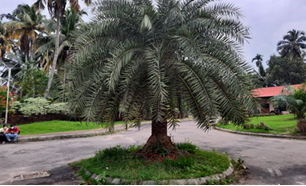
Date Palms
Date palms exhibit variable drought tolerance depending on the species. Some varieties are naturally adapted to desert oasis conditions, while others thrive along streams where they experience occasional flooding. The drought tolerance of palms varies by species and is influenced by additional factors including plant age, with established plants demonstrating significantly greater drought tolerance than young specimens. Environmental factors such as humidity levels, sun exposure intensity, and wind conditions also affect their water requirements and overall performance.
The campus maintains its lawns using buffalo grass, a species specifically selected for its ability to survive with minimal water inputs. This strategic grass selection ensures that recreational and aesthetic green spaces remain viable while adhering to water conservation principles.
The Chancellor of Amrita Vishwa Vidyapeetham actively encourages students to grow drought-tolerant plants and trees throughout the campus. This leadership commitment extends beyond administrative policy to direct engagement with the student community, fostering a culture of environmental awareness and sustainable practices. Through this guidance, students develop practical knowledge about water-conscious agriculture and landscaping that they can apply in their future professional and personal lives.

The following data demonstrates the remarkably low water requirements of drought-tolerant plants cultivated at Amrita, providing quantitative evidence of the water conservation achieved through strategic plant selection:
Agave americana, commonly known as the Century plant, requires only 18 gallons of water per year. Aloe vera demonstrates exceptional water efficiency with a requirement of merely 4 inches of water per year. Artemisia californica, or California sagebrush, needs approximately 12 inches of water annually. Ceanothus species, known as California lilac, requires around 20 inches of water per year. Dudleya species, also called Liveforever, needs only 6 inches of water annually. Encelia californica, the California encelia, requires approximately 12 inches of water per year. Eriogonum fasciculatum, or California buckwheat, needs about 10 inches of water annually. Hesperaloe parviflora, known as Red yucca, requires merely 15 gallons of water per year. Lavandula angustifolia, English lavender, needs approximately 20 inches of water annually. Leucophyllum frutescens, the Texas ranger, requires about 15 inches of water per year. Opuntia species, commonly known as Prickly pear, needs only 10 inches of water annually. Yucca schidigera, the Mojave yucca, requires approximately 12 inches of water per year.
Through the implementation of water-conscious planting practices, Amrita Vishwa Vidyapeetham demonstrates that environmental sustainability and aesthetic campus design are not mutually exclusive objectives. The strategic selection of drought-tolerant species, combined with efficient irrigation methods using recycled water, establishes a model for sustainable campus development that other institutions can emulate. The university’s approach integrates practical water conservation with educational opportunities, food production, and biodiversity preservation, creating a comprehensive framework for environmental stewardship that aligns with global sustainability goals while respecting local ecological conditions and cultural traditions.